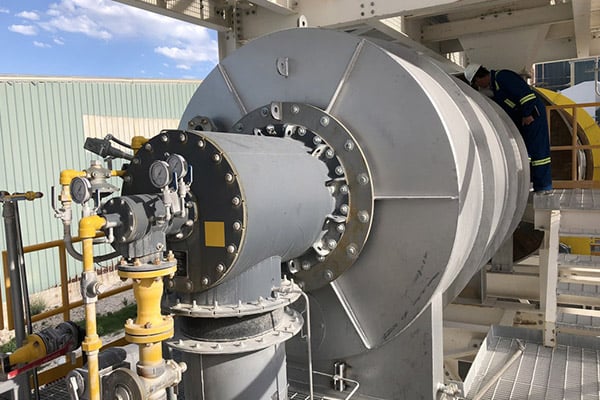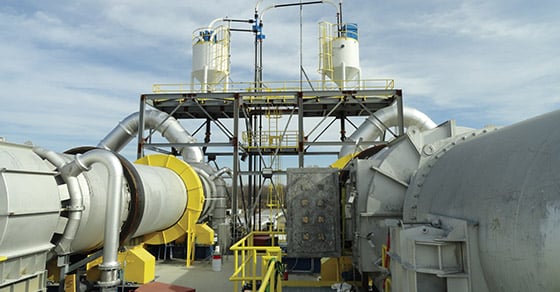Rotary kilns are used across a number of industries to cause a chemical reaction or phase change in a material. This high-temperature thermal treatment can be used to carry out a variety of different objectives, from catalyst activation to aluminum decoating. The number of applications to which rotary kiln systems can be applied continues to grow as their diverse capabilities expand into new markets.
Rotary kilns do not function as a standalone unit: they are accompanied by several pieces of equipment that form a complete thermal processing system.
The typical support equipment that makes up a complete kiln system is outlined below. In addition to our custom rotary kilns, FEECO can provide the listed equipment as part of a complete system.
Exhaust Gas Handling Systems & Equipment
All rotary kilns must be equipped with exhaust or flue gas handling equipment, sometimes referred to as a gas conditioning system. This system collects and treats (or “conditions”) any products of combustion, loss on ignition, gaseous emissions, and small particulates leaving the kiln in order to prevent air pollution and control emissions. The level of exhaust gas treatment required in a system is based on the unique emissions produced by the process, combined with local, state, and federal regulations.
Exhaust gas treatment systems can differ considerably based on the level of treatment needed, with indirect rotary kilns (calciners) requiring the most minimal treatment as a result of the process gases and material being kept separate.
Listed below are some of the most common types of exhaust gas handling equipment used for controlling emissions from rotary kilns.
Thermal Oxidizer/Secondary Combustion Chamber
Thermal oxidizers are the first step in any gas treatment process, serving to oxidize or break down volatile organic compounds (VOCs) into carbon dioxide (CO2) and water vapor (H2O).
Various types of thermal oxidizers exist, with a common configuration being the direct-fired type, also called a secondary combustion chamber or afterburner.
Quench Tower
The thermal oxidizer is typically followed by a quench tower. Quench towers are used to reduce the temperature of the hot gases exiting the oxidizer and take the gas stream to adiabatic saturation conditions.
After the quench tower, process gas typically moves on to a venturi scrubber (wet approach) for control of particulate emissions. The venturi scrubber can also be followed by a packed tower system for control of gaseous emissions.
Venturi Scrubber (Wet Method)
The venturi scrubber is a wet scrubber. This device uses primarily water to clean contaminants and particulates from exhaust gas.
Packed Tower (Wet Method)
Packed towers often follow venturi scrubbers for removal of gaseous emissions. Also a form of wet scrubber, packed towers use a scrubbing liquid to absorb or react with the contaminants in the gas.
The decision to utilize the wet scrubbing approach is dependent on the availability of water. The wet approach requires a significant water source and must be tied in to a sewer system, so it is often not an option in remote or water-constrained areas. If water and scrubber blowdown processing is an issue, then the dry scrubbing approach can be a more attractive alternative to control emissions.
In the dry scrubbing approach, the quench tower is typically followed by an evaporative cooler and baghouse.
Evaporative Cooler (Dry Method)
Evaporative coolers convert liquid water to water vapor via evaporation, immediately reducing the temperature of the gas.
Baghouse (Dry Method)
The baghouse is a dry scrubber that can be used to control both particulate and gaseous emissions. By incorporating a sorbent injection system into the baghouse configuration, the system can also control gaseous emissions such as SO2 and HCl. Activated carbon can also be introduced into the baghouse to control both heavy metals and Dioxin/Furan emissions as well.
The baghouse or bag filter collects any particulates that may have become entrained in the process gas and carried out through the exhaust air, which can especially be an issue when a high airflow velocity is combined with a fine material.
Not only do baghouses aid in air pollution control, but they can also be used to reduce wasted product; the dust and fines collected by the baghouse can often be recovered and reintroduced to the process, mitigating any waste lost as dust. In some operations, operators may choose to implement an agglomeration circuit to process baghouse fines or send them back to the process as recycle.
Wet Electrostatic Precipitators
Wet electrostatic precipitators (WESP) offer an alternative to wet scrubbers and baghouses for fine or sub-micron particulate removal. This type of device uses positive and negative electric charges to attract and hold particles so they are not released into the atmosphere. The system also requires some other type of scrubbing system (typically a cyclone or a venturi) to remove large particulates before entering the precipitator system. The WESP will also require a water source and blowdown.
Waste Heat Recovery Boiler
A common alternative to a quench tower is a waste heat recovery boiler (sometimes referred to as a heat recovery steam generator, or HRSG). This can be used with a venturi scrubber and optionally, a baghouse. In addition to reducing the temperature of the gas exiting the kiln or thermal oxidizer, it also allows for energy recovery and the production of steam for use in other areas of the facility.
While there are common approaches to gas handling, each system is unique. Depending on the application at hand and the necessary emissions requirements, a system may utilize any combination of the above technologies to best address their unique needs.
As these systems can be complex and must meet stringent criteria, the ideal configuration is best determined by an experienced expert.
It’s important to note that an induced draft (ID) fan is required in all systems. The use of an ID fan creates a negative pressure environment, drawing exhaust gas, air and particulates, or “flue gas” through the system to facilitate their removal. For this reason, the ID fan is always the last piece of equipment in the system, so it can be used to draw the exhaust through and create a negative pressure.
Combustion Requirements
In a direct rotary kiln, a controlled combustion reaction is used to produce the products of combustion. This requires a burner and in some cases, a combustion chamber.
Burner
The burner provides the source of combustion, using the fuel source, along with combustion and dilution air to create a combustion reaction that produces the required energy.
Burners can be designed to accept several fuel sources, including natural gas, propane, diesel, and more. In some settings, waste heat from various sources can be used to preheat the combustion air and improve burner efficiency and lower fuel costs. The combustion air required comes from a blower forcing air into the burner. An air-to-air heat exchanger can be used to raise the temperature of the burner combustion air, increasing the overall efficiency of the combustion system. Utilization of preheated combustion air will result in increased costs to the burner system and an evaluation needs to be undertaken to determine if the resulting increase in efficiency of the system actually provides a realistic advantage from a cost savings standpoint.
Combustion Chamber (Optional)
Combustion chambers are not required in all settings, but can be a valuable add-on. Combustion chambers serve to house the combustion reaction and direct the airflow into the kiln (either co-currently or counter currently).
Implementing a combustion chamber can offer a number of benefits. Perhaps most importantly, the addition of a combustion chamber can promote a quality product by preventing contact between the burner flame and the material being processed.
Combustion chambers are highly customizable. The base design of a FEECO combustion chamber offers the following benefits:
- Lower fuel cost through a more complete combustion of fuel
- More uniform results
- Avoidance of product breakdown
NOx Reduction
Nitrous oxides, or NOx gases, present in nearly every thermal processing operation, are becoming increasingly regulated. Not addressed in the aforementioned emissions control systems, NOx must be treated during combustion, or in post-combustion treatment.
This might include the use of low-NOx combustion systems when available, or post-combustion treatment methods such as SCR (selective catalytic reduction) and SNCR (selective non-catalytic reduction) to address these harmful pollutants.

Burner integrated into a combustion chamber
Product Cooling Requirements
Though not part of the rotary kiln system itself, rotary kilns are often accompanied by a rotary cooler for product cooling requirements.
Rotary coolers can be either direct or indirect water deluge, with the indirect configuration being favored for processing ultra-fine materials that would otherwise risk entrainment.
Bulk Material Handling Equipment
In addition to the immediate support equipment, various types of bulk material handling equipment will be required to transport material to and from the kiln. This might include screw conveyors, belt conveyors, bucket elevators, feeders, etc.
Conclusion
Rotary kilns are a critical component in many industrial bulk solids processing applications. These units often require a range of support equipment to integrate them into a process and to meet air pollution requirements.
FEECO is a leading supplier of custom rotary kilns and complete kiln systems. With experience around hundreds of materials, we can supply you with a complete thermal processing system around your unique process needs. We also offer low-NOx combustion systems. For more information on our kiln system capabilities, contact us today!



